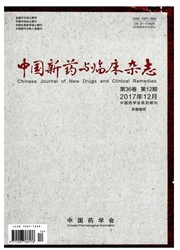

 中文摘要:
中文摘要:
目的探讨载长春西汀聚乙Z-醇-聚乳酸纳米粒(Vin纳米粒)在小鼠体内的药动学及组织分布。方法48只ICR小鼠随机平均分成两组。每组分别尾静脉注射长春西汀注射液(Vin注射液)和Vin纳米粒,给药剂量均为5mg·kg^-1,于给药后不同时间摘眼球取血并制备各组织样品,采用蛋白沉淀法提取药物。建立液相色谱-串联质谱联用(LC-MS/MS)分析方法测定血浆及各组织Vin浓度,用DAS2.0药动学软件计算药动学参数。以重量-平均总靶向系数(TE*)和AUQ0-t为指标评价纳米粒的组织分布及靶向性。结果小鼠血浆中Vin纳米粒的AUC0-t是Vin注射液的165.4倍;t1/2由0.47h延长到2.71h,增加5.76倍;MRT0-t增加4.58倍。Vin纳米粒在脑中的滞留时间为注射液的2.24倍,t1/2为注射液的3.97倍,AUC0-t增加1.62倍。静脉注射Vin纳米粒后,对肝和脾靶向明显;在血浆、心、肝、脾、肺、肾和脑组织中,Vin纳米粒的AUQ-t均大于Vin注射液的AUQ0-t,Vin纳米粒的总AUQ0-t是Vin注射液的65.58倍。结论Vin纳米粒可延长在体内的循环时间,提高生物利用度。
 英文摘要:
英文摘要:
AIM To investigate pharmacokinetics and tissue distribution of polyethylene glycol- polylactide nanoparticles containing vinpocetine (Vin nanoparticles) in mice. METHODS Forty-eight ICR mice were randomly divided into two groups. These two groups were intravenously administered Vin nanoparticles and vinpocetine (Vin) commercial injection, respectively. The dosage was 5 mg·kg^-1. Eyeballs of mice were picked out to collect blood samples after intravenous injection and tissue homogenate of experimental animal was made immediately. Samples were prepared by protein precipitation using methanol. The concentrations of Vin in plasma and tissue homogenate were detected by LC- MS/MS method, and pharmacokinetic parameters were calculated with DAS 2.0 software program. The influence of Vin nanoparticle on tissue distribution was evaluated by targeting efficiency (TE*) and AUQ0-t. RESULTS In plasma, the AUC0-t of Vin nanoparticles was 165.4 times of Vin commercial injection, the t1/2 was prolonged from 0.47 h to 2.71 h, and the MRT0-t was 4.58 times of Vin commercial injection, respectively. The mean residence time, tu2 and AUC0-t of Vin nanoparticle in brain was 2.24, 3.79 and 1.62 times of Vin commercial injection. The highest distribution of Vin occurred in liver and spleen of Vin nanoparticle. In plasma, heart, liver, spleen, lung, kidney and brain, the AUQ0-t of Vin nanoparticle was greater than Vin commercial injection. The total AUQ0-t of Vin nanoparticle was 65.58 times that of Vin commercial injection. CONCLUSION It can be concluded that Vin nanoparticles had a long-circulating behavior and improved the bioavailability of Vin.
 同期刊论文项目
同期刊论文项目
 同项目期刊论文
同项目期刊论文
 Lactoferrin-modified PEG-co-PCL nanoparticles for enhanced brain delivery of NAP peptide following i
Lactoferrin-modified PEG-co-PCL nanoparticles for enhanced brain delivery of NAP peptide following i The influence of the penetrating peptide iRGD on the effect of paclitaxel-loaded MT1-AF7p-conjugated
The influence of the penetrating peptide iRGD on the effect of paclitaxel-loaded MT1-AF7p-conjugated Glioma therapy using tumor homing and penetrating peptide-functionalized PEG-PLA nanoparticles loade
Glioma therapy using tumor homing and penetrating peptide-functionalized PEG-PLA nanoparticles loade F3 peptide-functionalized PEG-PLA nanoparticles co-administrated with tLyp-1 peptide for anti-glioma
F3 peptide-functionalized PEG-PLA nanoparticles co-administrated with tLyp-1 peptide for anti-glioma 期刊信息
期刊信息
